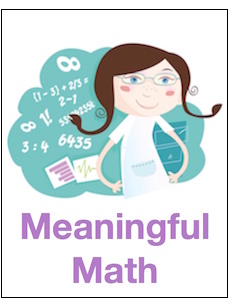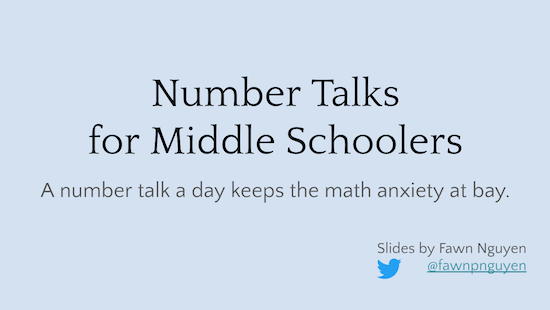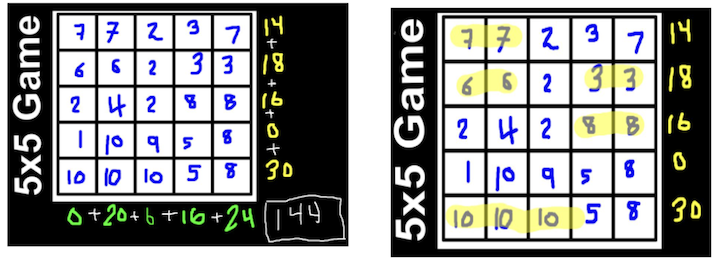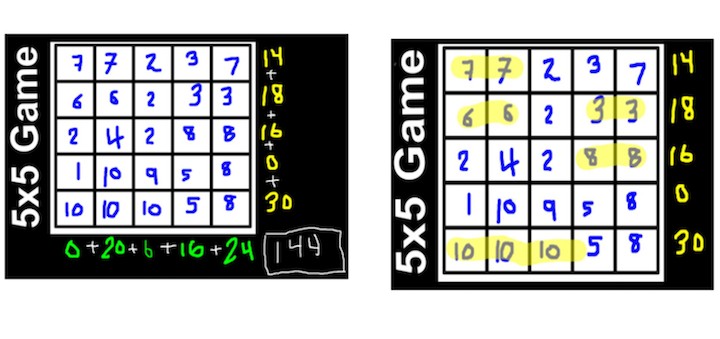A MiddleWeb Blog

 When I first started teaching, I found it very difficult to gauge how long a lesson would last. I was terrified that I would get observed and have a few minutes left at the end of the period and the students wouldn’t have anything to do.
When I first started teaching, I found it very difficult to gauge how long a lesson would last. I was terrified that I would get observed and have a few minutes left at the end of the period and the students wouldn’t have anything to do.
I’ve gotten better at timing my lessons, but there are still times that I need a short activity (5 or 10 minutes) to end the lesson. There are also times when we have an adjusted schedule and I need a short math task for my students.
If it is something I plan to use on the spur of the moment, I want it to be easy to access with no prep required. I also want an activity that will increase my students’ math fluency, logic skills, or number sense. I don’t want it to be something that has to be printed out or requires a key. I have a found a few activities that meet these requirements. Maybe they’ll be helpful to other teachers, too.
Measurement and Fractions
I came across a short video that explains how to read a tape measure. I showed it to my students, and I was surprised by how interested they were. This would be good for any class, but especially if you had recently been working on fractions.
Logic
Handshake problem
This is really interesting problem to think about. The idea is that you have a certain number of people in a room, say 15, and everyone can only shake hands with another guest one time. How many handshakes will take place?
The fun part to this one, presented by Dr. Raj Shah, is not the answer but how students go about working the problem. I saw this suggested several years ago at a math conference, and I have used it several times since then.
Number Talks
Number talks are short activities that help students improve their number sense, practice mental math, and learn how to explain how they worked a problem. They are perfect for when you have a short period of time and can be easily tailored to fit any math class. There are so many suggestions for number talks. The prompt could be as simple as “What is 68% of 25?” Students share out how they solved the problem. Just a word of caution, number talks are something that students have to be trained to participate in. I wouldn’t do a number talk on the spur of the moment if I hadn’t laid the groundwork ahead of time. This slide set provides preparation tips based on one teacher’s experience, problems you might use, and examples of student work.

Desmos and the 5×5 Game
This activity is on Desmos, and it’s so easy. When students enter their code, they are given a 5×5 board. The teacher calls out the numbers from a deck of cards with the face cards and aces removed (I use an online card deck). As each number is called out, students have to put it somewhere in their grid.
After all 25 spaces are filled, students highlight all the numbers that repeat in all the rows and columns, add those numbers together, and whoever has the highest sum wins. At the end of the game the students can discuss if they had a preferred strategy. (The activity on Desmos is by Michelle Schoenberg; the concept is by Sara van der Werf).
We actually played this today after a test, and it’s a lot of fun. One of the students at the beginning of class asked if he had to play, but by the end of the game he was asking if we had time to play again. I like it because it’s really easy for students to participate and the mental math they do to check each other’s totals is a bonus.
 Random.org offers a playing card shuffler.
Random.org offers a playing card shuffler.
Please share your own quick activities!
I feel more comfortable when I have back-ups, just in case I need to fill some extra time. And I’m always trying to add to my store of “five minute activities.” If you have any that you use, please share one below in the comments!








